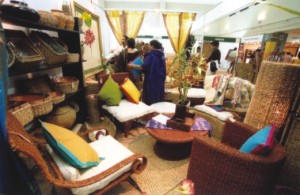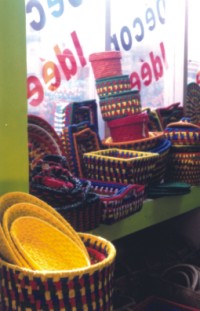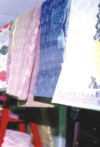Perspective
Buy Bangladeshi
Aasha Mehreen Amin
 A
couple of weeks ago there was a great deal of excitement over
a promotional event hosted by the proprietors of a popular
mall in Gulshan. Apparently two Hindi soap opera stars were
coming to inaugurate the event. Many women no doubt rushed
to the beauty parlour to look their best for Mr Bajaj, a character
in one of the most seen soaps. The mall in question also happened
to be 100 percent Indian. During a visit to the place, a supervisor
announced proudly: "Everything here is Indian. We don't
sell anything local". What she said was indeed true for
not only were the saris, jewellery, shalwar kameez sets etc,
all from India but even some of the salespeople. It maybe
mentioned that the 'local' clientele at this mall is considerable.
Many shopaholics consider this mall to be the ultimate shopping
experience because of all the glamorous stuff they sell. A
couple of weeks ago there was a great deal of excitement over
a promotional event hosted by the proprietors of a popular
mall in Gulshan. Apparently two Hindi soap opera stars were
coming to inaugurate the event. Many women no doubt rushed
to the beauty parlour to look their best for Mr Bajaj, a character
in one of the most seen soaps. The mall in question also happened
to be 100 percent Indian. During a visit to the place, a supervisor
announced proudly: "Everything here is Indian. We don't
sell anything local". What she said was indeed true for
not only were the saris, jewellery, shalwar kameez sets etc,
all from India but even some of the salespeople. It maybe
mentioned that the 'local' clientele at this mall is considerable.
Many shopaholics consider this mall to be the ultimate shopping
experience because of all the glamorous stuff they sell.
 So
what's the point? Well, for one thing, it is hard to understand
that when there is already such a huge invasion of Indian
and other foreign products in the regular markets, why do
we need a separate shopping complex devoted to exclusively
Indian goods? Of course the answer is that there is a demand
for it. The popularity of Hindi soap opera and Hindi film
actors and actresses, no doubt fuels the demand for clothes
that will make people look like them. So
what's the point? Well, for one thing, it is hard to understand
that when there is already such a huge invasion of Indian
and other foreign products in the regular markets, why do
we need a separate shopping complex devoted to exclusively
Indian goods? Of course the answer is that there is a demand
for it. The popularity of Hindi soap opera and Hindi film
actors and actresses, no doubt fuels the demand for clothes
that will make people look like them.
There
is of course nothing wrong with wanting to look like a beautiful
film star. But the problem is that as a result of this obsession
with foreign products, our local manufacturers are suffering.
Industries such as handlooms, textiles and handicrafts, not
to mention cosmetics, toiletries and even biscuits face unfair
competition from foreign producers. A few years ago, for instance,
Bangladeshi biscuits were just as good as those from any other
country. But in the last decade or so we see innumerable brands
of cookies and biscuits mostly from Malaysia and Thailand
pushing out the local brands from the shelves. Now we even
have to eat mangoes from Pakistan and India or 'golden delicious'
apples from Cape Town because there is such a dearth of local
fruits available in the market.
But
it is not just the non-availability of the products but also
the lack of interest among Bangladeshi consumers to buy things
from their own country. Many people still believe that Bangladeshi
goods are just not at par with their foreign counterparts.
This argument no longer carries much weight for certain products
such as garments, saris and fabrics given the fact that the
local versions are of high quality and design. Even the cosmetics
and pharmaceutical industries are coming up with goods of
high standards.
 The
need to make our own products more fashionable and attractive
cannot be emphasized enough. Recently, even the PM, in a refreshing
change of subject, has appealed to the public to buy Bangladeshi-made
products instead of foreign products for their Eid and Durga
shopping. This she said would help the thousands of poor weavers
whose livelihoods have been badly affected by the recent floods.
In recent years handloom products especially, have become
more popular among local consumers but not nearly enough to
capture a substantial share in the market. Urging people to
take pride in Bangladeshi goods, is certainly laudable move. The
need to make our own products more fashionable and attractive
cannot be emphasized enough. Recently, even the PM, in a refreshing
change of subject, has appealed to the public to buy Bangladeshi-made
products instead of foreign products for their Eid and Durga
shopping. This she said would help the thousands of poor weavers
whose livelihoods have been badly affected by the recent floods.
In recent years handloom products especially, have become
more popular among local consumers but not nearly enough to
capture a substantial share in the market. Urging people to
take pride in Bangladeshi goods, is certainly laudable move.
But
just telling people to buy things from their own land is not
enough. Ultimately in a free market people will go for good
quality and low price. In this respect many goods smuggled
in from neighbouring countries enjoy an unfair advantage as
their prices are at par or lower than the local goods. Lack
of good design is another crucial factor that stands in the
way of popularising our products. While some fashion houses
are trying to keep in tune with current trends, most manufacturers
do not invest much on designing the product to make it more
appealing than the foreign counterpart. In terms of exports,
the handicraft industry has suffered the most with exports
falling steadily. Without a proper design institute, handicraft
manufacturers find it increasingly difficult to cope with
a fickle foreign market, in terms of trends and tastes.
 Since
its independence, India closed its doors to foreign made goods
for over two decades to protect its own goods. Which is why
Indians had to make do with Indian cornflakes, sodas, chocolate,
cars, makeup, saris fabrics and pretty much everything else.
Of course we cannot expect an approach as strict as this in
present 'globalised' times. But it is high time that our own
industries are given the state support they need to be able
to compete with their rivals fair and square. From our part
consciously buying locally made products will go a long way
in helping them to get a decent share of the market. Who knows,
we might even have a mall or two selling only Bangladeshi
products with parlour-fresh women rushing in to meet their
'Made in Bangladesh' heartthrob of a star. Since
its independence, India closed its doors to foreign made goods
for over two decades to protect its own goods. Which is why
Indians had to make do with Indian cornflakes, sodas, chocolate,
cars, makeup, saris fabrics and pretty much everything else.
Of course we cannot expect an approach as strict as this in
present 'globalised' times. But it is high time that our own
industries are given the state support they need to be able
to compete with their rivals fair and square. From our part
consciously buying locally made products will go a long way
in helping them to get a decent share of the market. Who knows,
we might even have a mall or two selling only Bangladeshi
products with parlour-fresh women rushing in to meet their
'Made in Bangladesh' heartthrob of a star.
Copyright
(R) thedailystar.net 2004
|
